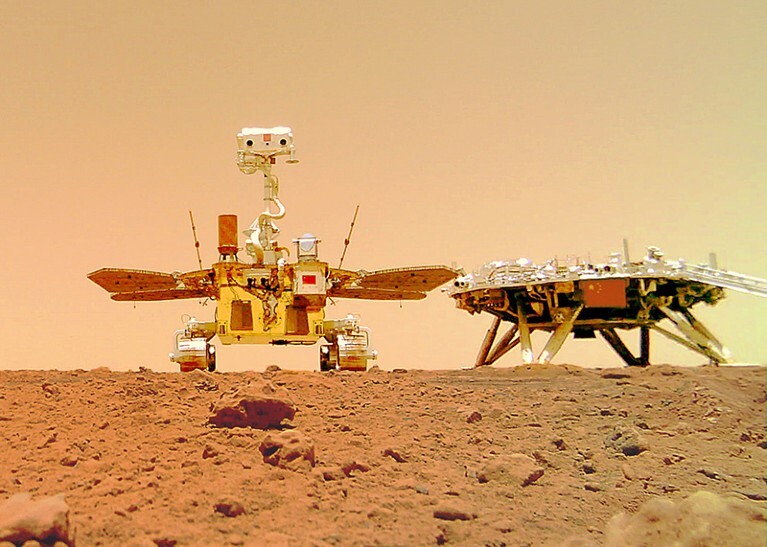China’s Zhurong rover has peered deep under the surface of Mars, finding evidence of two major floods that probably shaped the region the robot has been exploring since it landed in May 2021.
An analysis published in Nature today1 is the first result from Zhurong’s radar imager, which can probe up to 100 metres below the surface. “It is a very interesting paper, and I was particularly impressed by how deep they can see with this radar,” says Svein-Erik Hamran, a planetary scientist at the University of Oslo, who analysed the only previous data from ground-penetrating radar used on the planet, collected by NASA’s Perseverance rover.
The history of Zhurong’s landing site — on Utopia Planitia, vast plains in Mars’s northern hemisphere — has puzzled scientists. Some have theorized that water or ice was once a feature of the landscape. Observations from space have identified sedimentary deposits that suggest the region was once an ancient ocean or submerged by huge floods, and geological features, such as pitted cones, resemble structures formed by water or ice. In May, researchers analysed infrared images of the landing site taken by China’s Mars orbiter, Tianwen-1, and found hydrated minerals that could have formed when groundwater rose through the rock or ice melted.
But the region could have also been covered in lava, concealing some of these hydrological processes in the subsurface. Eruptions from the volcano Elysium Mons to the east of the landing site, or other volcanic activity, could have covered the region in magma, as has been observed in other parts of the Utopia basin. By studying the radar data, researchers hope to understand what happened, and whether water or ice could still be lurking below the rocks. “We want to know what is going on beneath the surface,” says study co-author Liu Yang, a planetary scientist at the National Space Science Center in Beijing.
Below the surface
Zhurong is China’s first rover on the red planet, and it has been exploring the southern part of Utopia Planitia. The rover’s ground-penetrating radar transmits high-frequency radio waves that can penetrate the surface to a depth of between 3 and 10 metres, and low-frequency waves that can reach up to 100 metres underground but offer poorer resolution. The study authors analysed low-frequency data taken between 25 May and 6 September over more than 1,100 metres of terrain as Zhurong travelled south of its landing site. Radar signals reflect off materials under the surface, revealing the size of their grains and their ability to hold an electric charge. Stronger signals typically indicate larger objects.
The radar did not find any evidence of liquid water down to 80 metres, but it did detect two horizontal layers with interesting patterns. In a layer between 10 and 30 metres deep, the team reports, the reflection signals strengthened with increasing depth. The researchers say this is probably due to larger boulders resting at the base of the layer, and smaller rocks settling on top. An older, thicker layer between 30 and 80 metres down showed a similar pattern.
The older layer is probably the result of rapid flooding that carried sediments to the region more than three billion years ago, when there was a lot of water activity on Mars, says co-author Chen Ling, a seismologist at the Institute of Geology and Geophysics, Chinese Academy of Sciences, in Beijing.
The upper layer could have been created by another flood some 1.6 billion years ago, when there was lots of glacial activity. Chen says it is unlikely that the upper layer contains intact lava flows, because it has a smaller ability to hold an electric charge than would be expected for intact volcanic rocks. Furthermore, the researchers didn’t see any sudden changes in layering, which would be expected when lava flows meet sedimentary material.
Volcanic or sedimentary?
But, Chen says, it is possible that a thin coat of lava once covered the upper layer and it has gradually been broken down into smaller pieces. Radar data alone cannot definitively reveal whether material is sedimentary or volcanic, says Xu Yi, a planetary scientist at Macau University of Science and Technology.
Radar data are good at indicating the layering and geometry of subsurface material, but not so good at pinpointing its composition, including whether the material is ice or rock, says Hamran. Often, researchers rely on other clues, such as rocks peering out from the surface, to build a picture of past events, he says. The authors say they can’t rule out the possibility that the region contains buried saline ice.
More radar results are expected from the mission, including data taken during Zhurong’s continued traverse of Mars, results from the high-frequency radar measurements already made, and Tianwen-1’s orbital radar observations, which penetrate deep into the planet. They could help to clarify details of the terrain. “This is only the first step,” say Ling.
Quelle: nature
----
Update: 4.10.2022
.
China's Mars rover reveals more of subsurface

What does the subsurface of Mars' northern lowlands have in common with a French mille crepe cake? They both consist of a number of layers, according to the latest findings by China's Zhurong Mars rover published in the journal Nature on Monday.
The discovery showed that the evolution of the Martian surface environment is more varied and complex than previously anticipated, experts said. Last year, the Zhurong rover landed in Utopia Planitia, a large plain that scientists suspect was once a massive ancient ocean.
Although the rover didn't detect liquid water up to 80 meters underground, the subsurface layer from 30 to 80 meters may be shaped by major flooding that took place around 3.2 to 3.5 billion years ago, said Chen Ling, a researcher at the Institute of Geology and Geophysics of the Chinese Academy of Sciences.
For the layer between 10 and 30 meters underground, the strata were likely sculpted by smaller floods, meteorite impacts or long-term weathering during the Middle to Late Amazonian periods about 1.6 billion years ago, she said.
"What does Mars' underground look like, how did it evolve and whether there are water or ice buried deep under the Martian surface are very important scientific questions that have garnered a lot of attention," she said. "The Zhurong rover may provide valuable insights into these key questions."
Xiao Long, an astrogeology professor at China University of Geosciences, Wuhan, said Zhurong's onsite data can help scientists figure out whether an ancient ocean had existed on Utopia Planitia, and where the water went if there had been an ocean.
The rover is equipped with six major scientific instruments, allowing researchers to study local geology, the chemical composition of rocks and local weather conditions.
In March, scientists reported finding grooves and etchings from particles carried by wind on rocks around Zhurong's landing site, suggesting that physical weathering such as impact sputtering and wind erosion, as well as aqueous interactions involving salt and brine are factors that shaped Mars' current surface.
On July 2020, China's Tianwen 1 Mars spacecraft took off from the Wenchang spaceport and entered Mars orbit in February 2021. The feat made China the first nation to carry out an orbiting, landing and roving mission to Mars on its maiden attempt.
As a result, the mission received the International Astronautical Federation's annual space achievement award on Sept 18 during the 73rd International Astronautical Congress in Paris.
Quelle: SD
----
Update: 11.01.2023
.
China's 1st Mars rover and Tianwen 1 orbiter may have gone silent: report
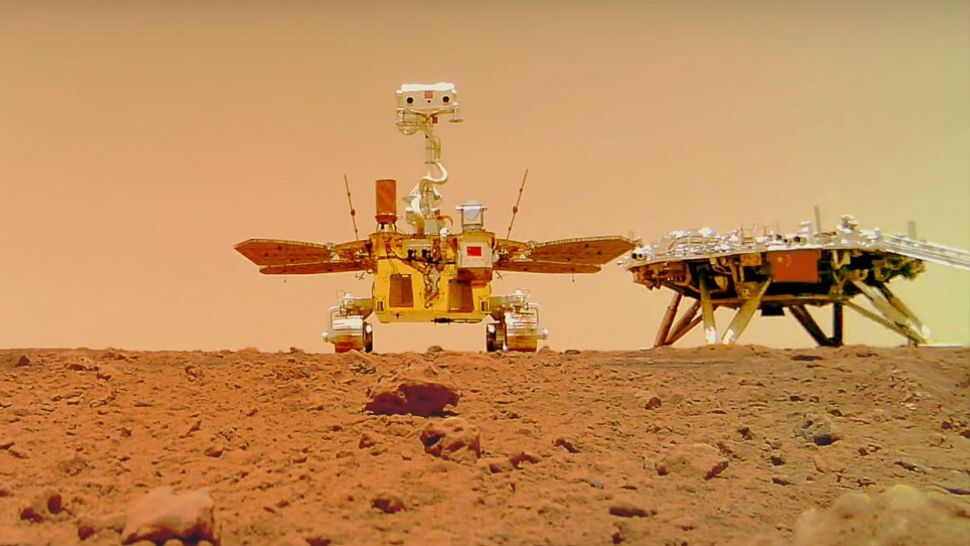
A 'selfie' taken by China's Zhurong Mars rover during the Tianwen-1 mission. (Image credit: China News Service)
Something may have gone very wrong for China's first-ever Mars mission.
China launched Tianwen 1 in July 2020 and the mission's rover, named Zhurong, touched down on the Red Planet in May 2021. The duo explored Mars smoothly until May 2022, when Zhurong was put into hibernation, hunkering down for the harsh winter.
But the rover may not have exited hibernation as expected, according to reports from Space News(opens in new tab), which cite reporting from the South China Morning Post(opens in new tab)(SCMP), an English-language newspaper based in Hong Kong, that Zhurong was expected to wake up in December and hasn't called home yet. And simultaneously, the Tianwen 1 Mars orbiter appears to be experiencing a communications glitch.
Zhurong entered hibernation in May 2022 to help it ride out the low temperatures, dust storms and sand storms common in Martian winter. The rover features a special anti-dust coating on its solar panels, which it angled before hibernating in anticipation of the storms and its subsequent emergence from hibernation.
Nevertheless, it appears something has gone wrong. Unnamed sources told the SCMP that teams on Earth have yet to receive signal from the rover following hibernation. It's unknown what the issue might be, but an unnamed source told SCMP that "most likely the sandstorms have seriously weakened Zhurong's capacity to use its solar panels to generate power."
There's more bad news for China's space agency: It appears that the Tianwen 1 orbiter has also gone quiet. The orbiter initially scouted for landing locations for Zhurong before serving as a communications relay for the rover. Since then, the Tianwen 1 orbiter has been carrying out its own science program, including surveying and mapping the Red Planet.
"A Beijing-based source said ground control had encountered difficulty when downloading the latest data from the orbiting probe, which is equipped with two cameras," South China Morning Post wrote. Amateur radio operators have even observed that Tianwen 1 ground stations appear to have stopped attempting to make contact(opens in new tab) with the orbiter.
China's space agency has yet to comment on the issues with Zhurong and Tianwen 1.
Quelle: SC
----
Update: 20.01.2023
.
Will China's Zhurong Mars rover wake up from its worrying hibernation?
There's still reason for hope, according to mission team members.
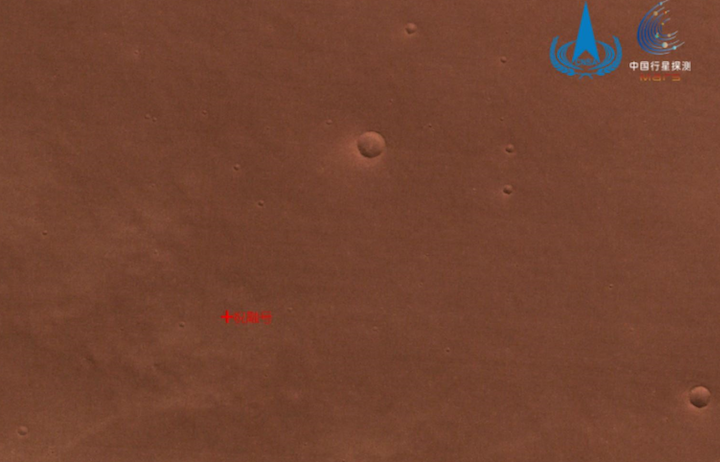
Evidence of sand and dust activity over Utopia Planitia, imaged by the Tianwen 1 orbiter's medium resolution camera, taken on April 30, 2022. (Image credit: CNSA/PEC)
China's Zhurong Mars rover remains silent despite being expected to wake up in December — but there's still hope that the vehicle could rise from its slumber.
Zhurong is part of Tianwen 1, China's first interplanetary mission, which also includes a Mars orbiter. The rover touched down on the Red Planet's Utopia Planitia back in May 2021 and conducted a range of science and explorationactivities before entering a dormant state in May 2022 to wait out the cold, harsh winter in the northern hemisphere of Mars.
Zhurong was expected to wake up in December, around the time of the Marsspring equinox. So far, however, there has been silence from both the rover and its operators in China, with reports that the spacecraft could be in trouble.
Yet hope remains that Zhurong is simply experiencing colder than expected conditions and may still wake itself up and resume activities.
Jia Yang, a Tianwen 1 mission deputy chief designer, told(opens in new tab) reporters in September 2022 that Zhurong would wake up autonomously when two conditions are met. These are a temperature of greater than 5 degrees Fahrenheit (minus 15 degrees Celsius) and energy generation of greater than 140 watts.
Weather data from NASA's Perseverance rover — which is nuclear-powered and has not needed to hibernate — reveals that temperatures in Mars' Jezero Crater have only briefly risen higher than this lowest heat requirement. Perseverance is also some seven degrees latitude south of Zhurong and thus closer to the Martian equator, meaning it may also be experiencing slightly more favorable conditions than China's rover.
The other factor affecting Zhurong is that dust storms may have deposited Martian sand onto Zhurong's solar arrays, hindering its ability to generate power and wake itself up. The rover's butterfly-shaped solar panels use anti-dust material, and Zhurong is equipped with a vibrating function to shake off accumulated dust. However, the rover will need to be active to employ this latter measure.
Time will tell if Zhurong will roll along the Martian surface once more, but the mission has already been a huge success. The landing made China the second country to successfully operate a rover on Mars after the U.S., and both Zhurong and the Tianwen 1 orbiter have completed their primary missions.
Quelle: SC
----
Update: 11.02.2023
.
China Focus: Tianwen-1 marks 2 years in Martian orbit
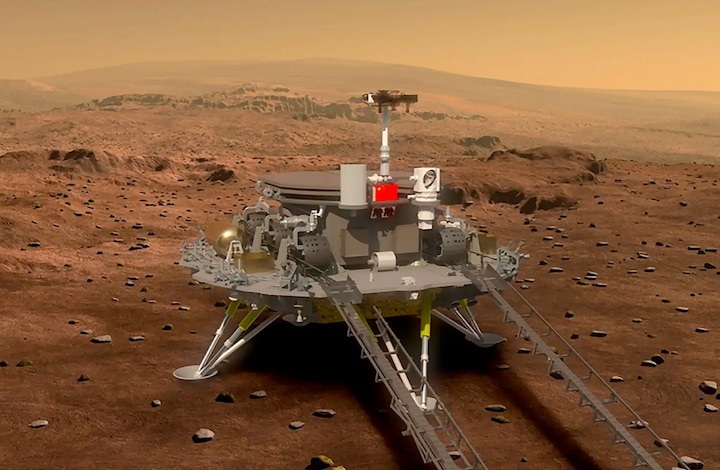
It has been two years since China's Tianwen-1 probe slipped into orbit around Mars. The orbiter has carried scientific instruments on its journey and relayed a torrent of data to Earth, making contributions to many interplanetary exploration discoveries in that time.
But it has done far more than that. The China National Space Administration on Friday said that the Tianwen-1 orbiter was in good condition and would continue to perform multiple tasks related to the red planet.
What follows is a partial list of Tianwen-1's many accomplishments.
The Chinese Mars probe consists of an orbiter, a lander and a rover. On Feb. 10, 2021, Tianwen-1 entered the Mars orbit after a nearly seven-month voyage from Earth, becoming the country's first satellite to orbit the planet.
On May 15, 2021, it touched down at its pre-selected landing area in Utopia Planitia, a vast Martian plain, marking China's first probe landing on the planet. A week later on May 22, 2021, the Mars rover Zhurong, which resembles a butterfly, drove down from its landing platform to the Martian surface. After that, the Tianwen-1 orbiter provided Zhurong with relay communications for nearly six months.
By Dec. 29, 2022, the orbiter had been operating for 687 Earth days, completing one Martian year.
Payloads on the orbiter, including advanced cameras and detectors, have beamed back abundant images of Mars over the past two years, and these images are now helping Chinese researchers to draw a high-resolution, full-color image of the planet, the space administration said.
The Tianwen-1 orbiter thoroughly studied the Martian surface. Even though it suspended explorations when the sun blocked communications with Earth between September and October 2021, it still offered useful engineering data for Chinese and foreign scientists during that period, and that data has contributed to several notable scientific research results.
Quelle: Xinhua
----
Update: 2.03.2023
-
China's Zhurong rover reveals complex layers beneath the surface of Mars
New glimpses into the Martian subsurface reveal buried craters and other features.
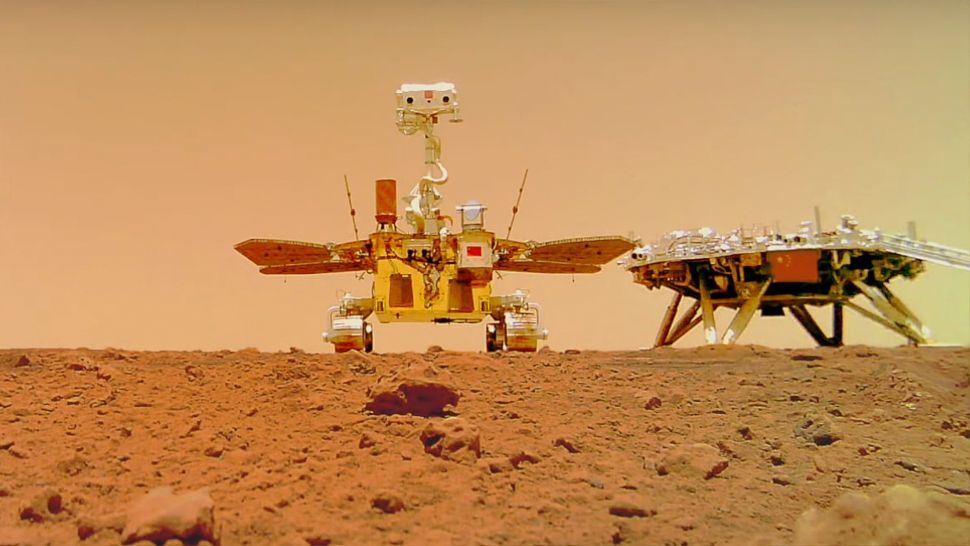
China's Zhurong rover has provided one of the few peeks into what lies below the surface of Mars.
Data returned by Zhurong's ground-penetrating radar instrument reveals evidence of craters buried just under the surface of Mars and other, sloping features with less certain origins, according to a new paper.
This view of the Martian surface, which shows several clear features, contrasts starkly with the shallow subsurface structure of Earth's moon, also revealed by ground-penetrating radars. The moon's uppermost 33 feet (10 meters) consists of fine layers that have been ground up by a bombardment of micrometeorite strikes.
The difference may be explained by Mars' thin atmosphere, which offers protection against micrometeorites and also has weathering effects on the surface.
"We found a lot of dunes on the surface at the landing site, so maybe this crater was quickly buried by the sand and then this cover reduced space weathering, so we can see the full shape of these craters' walls," Yi Xu, the lead author on the study, said in a statement(opens in new tab).
Zhurong launched in July 2020 along with the Tianwen 1 mission orbiter and landed in the large plain of Utopia Planitia in May 2021. The rover traveled 6,302 feet (1,921 meters) south from its landing site over the following Earth year.
The landing site was selected for engineering and science criteria, with the area thought to host shorelines of a possible ancient ocean. One objective for Zhurong's ground-penetrating radar — which pings electromagnetic signals off subsurface rocks and collects their reflections — was seeking evidence of water or ice trapped below the surface.
It uses two different frequency ranges, with the frequency used for this study providing fine detail but only to a depth of around 15 feet (4.5 m). No water was found in this study, but the other radar frequency reaches down to around 260 feet (80 m).
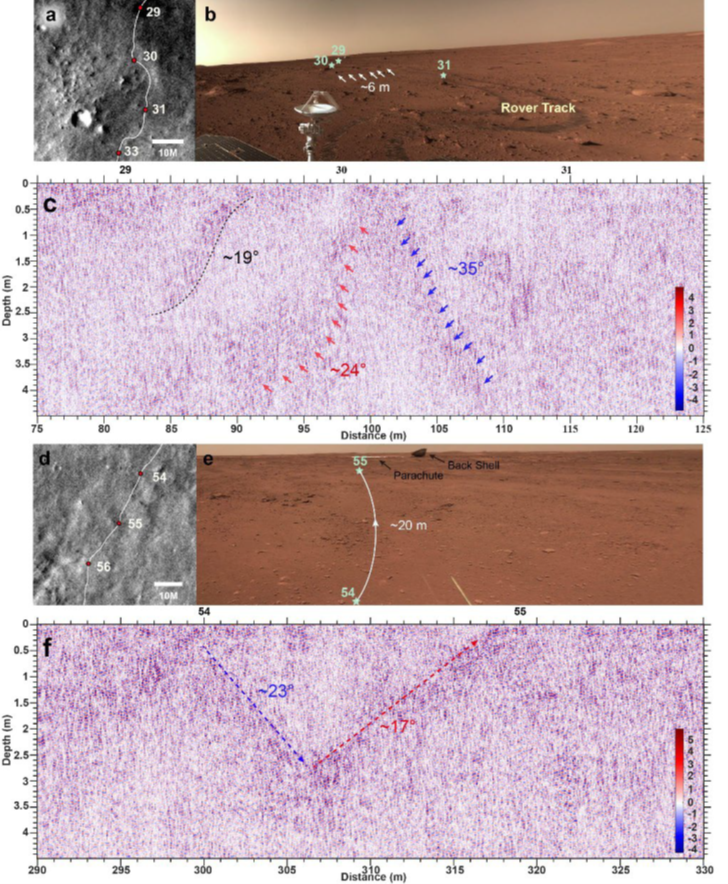
Maps, pictures and radar images of sloping reflectors traversed by China's Zhurong Mars rover. (Image credit: CNSA/Chen et al./GSA)
Researchers hope that opening this window onto the subsurface of Mars will provide insight into Mars's geological development, clues about earlier climate conditions and possibly evidence of the presence of water or ice. NASA's Perseverance also carries a ground-penetrating radar instrument, providing new insights into its environs, the floor of Mars' Jezero Crater.
The research article was published(opens in new tab) on Feb. 9 in the journal Geology of the Geological Society of America.
Meanwhile, the fate of the Zhurong rover itself is currently unknown. The solar-powered rover entered hibernation in May 2022 due to the approaching winter in Mars' northern hemisphere. It was expected to resume activities autonomously in December, but Chinese space authorities have not commentedon the rover's apparent silence.
NASA's Mars Reconnaissance Orbiter recently imaged Zhurong from orbit, showing that the rover has not moved since its hibernation period began. The rover could awaken as heat and light conditions improve in Utopia Planitia.
Quelle: SC
----
Update: 16.03.2023
.
China's Zhurong Mars rover reveals seasonal wind changes in Red Planet weather report
Data collected by China's Zhurong rover shows seasonal changes in the strength and direction of winds on Mars.

Data collected by China's Zhurong rover shows seasonal changes in the strength and direction of winds on Mars.
Zhurong launched in July 2020 along with the Tianwen 1 mission orbiter and landed in the large plain of Utopia Planitia in May 2021. Among its science instruments is the Mars Climate Station (MCS), designed to provide new insight into meteorological activity on the Red Planet.
An initial analysis of MCS data shows that surface pressure on Mars varies greatly from sol to sol (Martian days) while also having seasonal variations. Air temperature ranges and its seasonal changes are also reported, with the average temperature recorded during the mission by Zhurong about 268 Kelvin (22.7 degrees Fahrenheit or minus 5.1 degrees Celsius) and the lowest is about 218 K (minus 67 degrees F or minus 55 degrees C.
Wind data from Zhurong was also collected over the course of half a Martian year, from early summer until around fall equinox in the northern hemisphere. It shows changing wind patterns, with a maximum recorded wind speed of 54.8 feet per second (16.7 m/s) or 37 mph (60 kph).
The wind blew close to true south from the northern summer solstice, shifting to southeastwards until the northern fall equinox. The data adds to payloads collecting meteorological data aboard the InSight and Perseverance missions, helping to provide a more global understanding of weather on Mars.
The research was published(opens in new tab) in the journal Nature on Feb. 27, assessing meteorological data returned from the first 325 sols of the Tianwen 1 mission.
Zhurong traveled 6,302 feet (1,921 meters) south from its landing site across the time of an Earth year. The rover has notably revealed complex layers beneath the surface of the Red Planet using its ground-penetrating radar, as well as found evidence of how ancient water altered rocks on its surface.
The status of the Zhurong rover itself is currently unknown. The solar-powered rover entered hibernation in May 2022 due to the approaching winter in Mars' northern hemisphere and was expected to resume activities autonomously in December.
Chinese space authorities have not provided an update on the rover, however. Images recently taken by NASA's Mars Reconnaissance Orbiter confirm that the rover has not moved in months. It is unknown if Zhurong can reactivate itself as lighting and temperature levels increase on the Red Planet.
Quelle: SC
----
Update: 29.04.2023
.
China's Mars rover may never wake up because of Martian dust
The mission's chief designer says the rover has most likely been hampered by dust.
The chief designer of China's Mars exploration program has provided a long-awaited comment on the status of the country's Zhurong Mars rover.
The solar-powered Zhurong rover, which is part of China's Tianwen 1 Mars mission, had been hibernating during winter in the planet's northern hemisphere since May 2022. It was expected to wake up autonomously in December, once lighting conditions and temperature had improved.
However, China remained silent regarding Zhurong as December came and went. NASA's Mars Reconnaissance Orbiter confirmed in February that the rover has remained stationary for months.

This sequence shows the buildup of dust on the solar panels of China's Zhurong Mars rover. (Image credit: CNSA/CCTV)
Now, mission chief designer Zhang Rongqiao told China Central Television this week that the team believes Zhurong has not woken up because a higher-than-expected amount of dust has accumulated on the rover's solar panels. This means sunlight received by Zhurong has not been sufficient for it to wake up.
"We estimate that the biggest possibility is that the unpredictable accumulation of dust on Mars has led to a decrease in power generation capacity, which is not high enough to wake it up," Zhang said.
The threshold for Zhurong to resume activities is a temperature of greater than 5 degrees Fahrenheit (minus 15 degrees Celsius) and energy generation of greater than 140 watts.
Zhang said that if dust levels on the panels were 30% greater than expected, then Zhurong would require the strongest sunlight levels on Mars to reactivate. A level of 40% or more above expected levels would mean the rover will not be able to wake up.
Summer solstice in the northern hemisphere on Mars occurs in mid-July, according to the Planetary Society(opens in new tab), when lighting and temperature conditions may be the most favorable.
Both of NASA's long-lived Spirit and Opportunity rovers finally succumbed to Martian dust covering their solar panels, reducing power generation to below adequate levels for operation.
Zhurong landed in Utopia Planitia in May 2021, marking success at the first attempt at a Mars landing for China. The rover entered a dormant mode in May 2022.
Whether or not Zhurong comes back to life, the mission already exceeded its planned lifetime of three Earth months. The rover has also, like its companion Tianwen 1 orbiter, completed its primary science goals.
Quelle: SC
----
Update: 30.04.2023
.
China's Mars rover finds signs of recent water in sand dunes
A new study suggests water on Mars may be more widespread and recent than previously thought

CAPE CANAVERAL, Fla. -- Water may be more widespread and recent on Mars than previously thought, based on observations of Martian sand dunes by China's rover.
The finding highlights new, potentially fertile areas in the warmer regions of Mars where conditions might be suitable for life to exist, though more study is needed.
Friday's news comes days after mission leaders acknowledged that the Zhurong rover has yet to wake up since going into hibernation for the Martian winter nearly a year ago.
Its solar panels are likely covered with dust, choking off its power source and possibly preventing the rover from operating again, said Zhang Rongqiao, the mission's chief designer.
Before Zhurong fell silent, it observed salt-rich dunes with cracks and crusts, which researchers said likely were mixed with melting morning frost or snow as recently as a few hundred thousand years ago.
Their estimated date range for when the cracks and other dune features formed in Mars’ Utopia Planitia, a vast plain in the northern hemisphere: sometime after 1.4 million to 400,000 years ago or even younger.
Conditions during that period were similar to now on Mars, with rivers and lakes dried up and no longer flowing as they did billions of years earlier.
Studying the structure and chemical makeup of these dunes can provide insights into "the possibility of water activity" during this period, the Beijing-based team wrote in a study published in Science Advances.
"We think it could be a small amount ... no more than a film of water on the surface,” co-author Xiaoguang Qin of the Institute of Geology and Geophysics said in an email.
The rover did not directly detect any water in the form of frost or ice. But Qin said computer simulations and observations by other spacecraft at Mars indicate that even nowadays at certain times of year, conditions could be suitable for water to appear.
What’s notable about the study is how young the dunes are, said planetary scientist Frederic Schmidt at the University of Paris-Saclay, who was not part of the study.
“This is clearly a new piece of science for this region,” he said in an email.
Small pockets of water from thawing frost or snow, mixed with salt, likely resulted in the small cracks, hard crusty surfaces, loose particles and other dune features like depressions and ridges, the Chinese scientists said. They ruled out wind as a cause, as well as frost made of carbon dioxide, which makes up the bulk of Mars’ atmosphere.
Martian frost has been observed since NASA’s 1970s Viking missions, but these light dustings of morning frost were thought to occur in certain locations under specific conditions.
The rover has now provided “evidence that there may be a wider distribution of this process on Mars than previously identified,” said Trinity College Dublin’s Mary Bourke, an expert in Mars geology.
However small this watery niche, it could be important for identifying habitable environments, she added.
Launched in 2020, the six-wheeled Zhurong — named after a fire god in Chinese mythology — arrived at Mars in 2021 and spent a year roaming around before going into hibernation last May. The rover operated longer than intended, traveling more than a mile (1,921 meters).
Quelle: abcNews
----
Update: 1.05.2023
.
Tianwen-1: Zhurong Rover Finds Evidence of Water at Low Latitudes on Modern Mars
The Zhurong rover has found evidence of water on dune surfaces on modern Mars by providing key observational proof of liquid water at low Martian latitudes, according to a study led by Prof. QIN Xiaoguang from the Institute of Geology and Geophysics (IGG) of the Chinese Academy of Sciences (CAS).
The study was published in Science Advances on April 28.
Researchers from the National Astronomical Observatories of CAS and the Institute of Atmospheric Physics of CAS were also involved in the study.
Previous studies have provided proof of a large amount of liquid water on early Mars, but with the escape of the early Martian atmosphere during the later period, the climate changed dramatically. Very low pressure and water vapor content make it difficult for liquid water to sustainably exist on Mars today. Thus, it has been widely believed that water can only exist there in solid or gaseous forms.
Nonetheless, droplets observed on the Phoenix's robotic arm prove that salty liquid water can appear in the summer at current high latitudes on Mars. Numerical simulations have also shown that climatic conditions suitable for liquid water can briefly occur in certain areas of Mars today. Until now, though, no evidence has shown the presence of liquid water at low latitudes on Mars.
Now, however, findings from the Zhurong rover fill the gap. The Zhurong rover, which is part of China's Tianwen-1 Mars exploration mission, successfully landed on Mars on May 15, 2021. The landing site is located at the southern edge of the Utopia Planitia (UP) Plain (109.925 E, 25.066 N), where the northern lowlands unit is located.
The researchers used data obtained by the Navigation and Terrain Camera (NaTeCam), the Multispectral Camera (MSCam), and the Mars Surface Composition Detector (MarSCoDe) aboard the Zhurong rover to study the different-scale surface features and material compositions of dunes in the landing area.
They found some important morphological features on the dune surfaces, such as crusts, cracks, granulation, polygonal ridges, and a strip-like trace. The analysis of spectral data revealed that the dune surficial layer is rich in hydrated sulfates, hydrated silica (especially opal-CT), trivalent iron oxide minerals (especially ferrihydrite), and possibly chlorides.
"According to the measured meteorological data by Zhurong and other Mars rovers, we inferred that these dune surface characteristics were related to the involvement of liquid saline water formed by the subsequent melting of frost/snow falling on the salt-containing dune surfaces when cooling occurs," said Prof. QIN.
Specifically, salts in dunes cause frost/snow to melt at low temperatures to form salty liquid water. When the saline water dries, the precipitated hydrated sulfate, opal, iron oxide, and other hydrated minerals cement sand particles to form sand aggregates and even crust. Then the crust is further cracked by shrinkage. The later frost/snow melting process further forms polygonal ridges and a strip-like trace on the crust surface.
The estimated age of the dunes (about 0.4–1.4 million years) and the relationship among the three phases of water suggest that the transfer of water vapor from the polar ice sheet toward the equator during the large obliquity stages of Mars's late Amazonian period led to repeated humid environments at low latitudes. Therefore, a scenario of water activity has been proposed, i.e., cooling at low latitudes during Mars's large obliquity stages prompts frost/snow to fall and subsequently results in the formation of crusts and aggregates on the salty dune surface, thus solidifying dunes and leaving traces of liquid saline water activity. The discovery provides key observational evidence of liquid water at Martian low latitudes, where surface temperatures are relatively warmer and more suitable for life than at high latitudes.
"This is important for understanding the evolutionary history of the Martian climate, looking for a habitable environment, and providing key clues for the future search for life," said Prof. QIN.
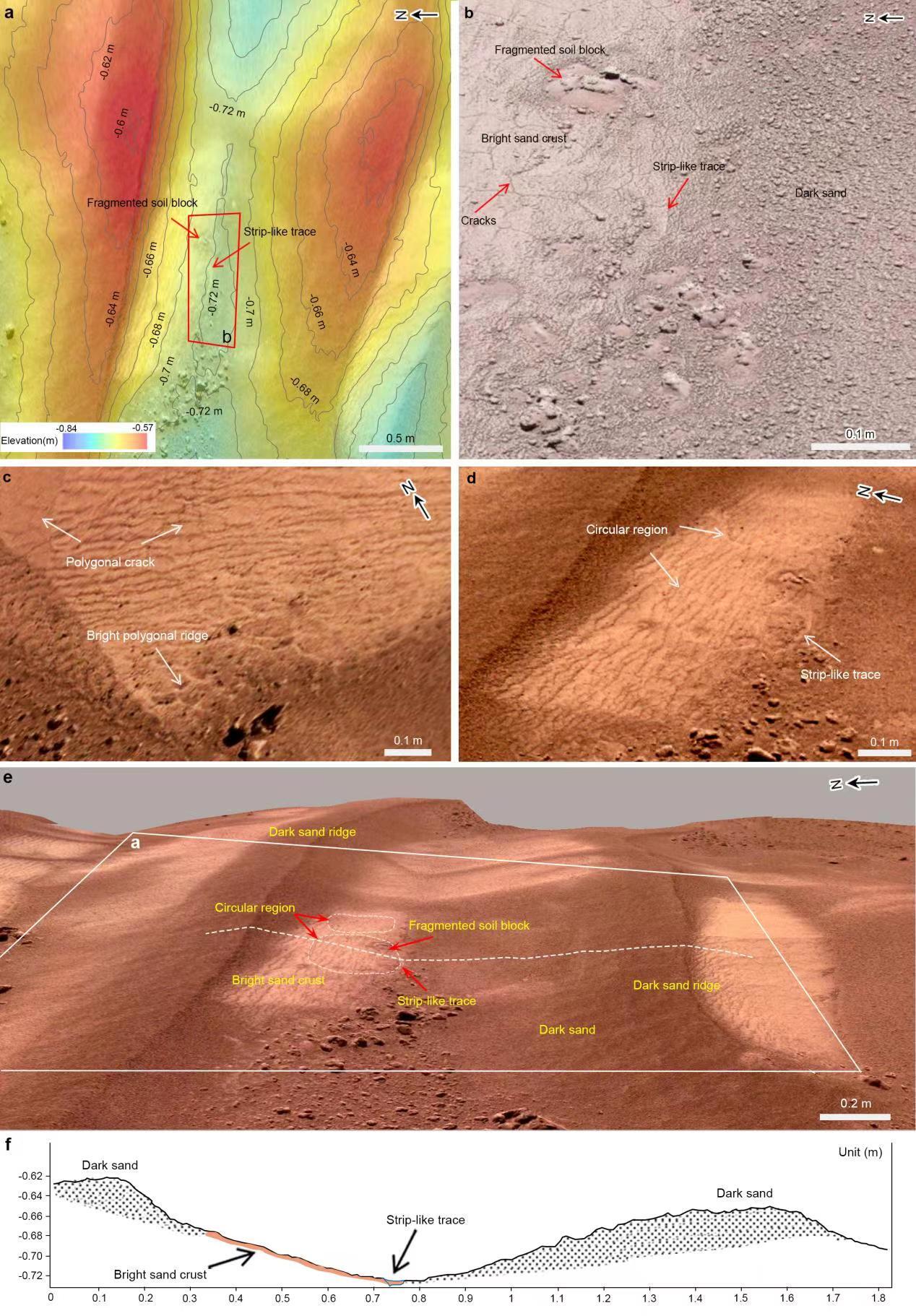
Water traces on bright sand dunes. (a) Topographic contour map of the environs where the trace is located. The coordinate system is east-north-up (ENU) local Cartesian coordinate and the origin is that of the rover coordinate system. The background Digital Orthophoto Map (DOM) photo was taken by NaTeCam. (b) MSCam bird’s-eye-view photo showing a strip-like trace and a likely water-soaked fragmented soil block. (c) Enlarged photo showing polygonal cracks and bright polygonal ridges. (d) Enlarged photo showing circular region with the strip-like trace as a part. (e) NaTeCam 3D image of an interdune depression between two dark longitudinal dunes. (f) A cross-section of the dune along the profile of the white dash line in (e). (Image by IGGCAS)
Quelle: Chinese Academy of Sciences



